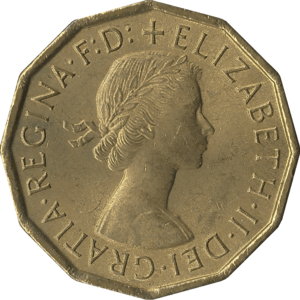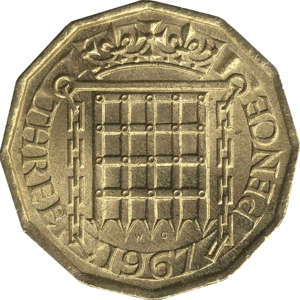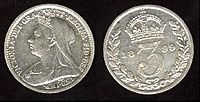Threepence (British coin) facts for kids
The threepence coin was a British coin that was worth one-eightieth of a pound. It was also worth a quarter of a shilling. People in the United Kingdom, Great Britain, and England used this coin. Other countries in the British Empire and Commonwealth, like Australia, New Zealand, and South Africa, also used similar coins.
People called the threepence by different names, like thruppence or thruppenny bit. Before 1971, the British money system was different. A pound was divided into 20 shillings, and each shilling had 12 pence. The threepence coin was removed in 1971 when Britain switched to a decimal system. This new system used the new penny, where 2.4 old pence were equal to 1 new penny.
Contents
- The First Threepence Coins
- Threepence Coins Return
- Coins in the Late 1600s
- Coins in the Early 1700s
- The Threepence Changes Its Purpose
- Queen Victoria's Threepence
- Early 1900s Threepence
- Brass vs. Silver Threepence
- Elizabeth II Threepence
- Threepence in Other Countries
- A Building Like a Coin
- Nickname of the Coin
- The 12-Sided Coin Returns
- Big Sale of Threepence Coins in 2019
- See also
The First Threepence Coins
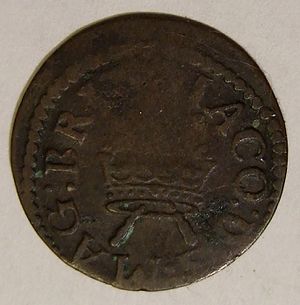
The threepence coin, written as "3d", first appeared in England during the rule of King Edward VI (1547–1553). It was part of a new set of coins. Even though it was easy to use in the old money system (it was exactly a quarter of a shilling), people didn't like it much at first. They preferred the groat, which was worth four pence. Because of this, the coin wasn't made during the next two reigns.
Edward VI's threepence coins were made in London and York. The front side (called the obverse) showed the king's face looking forward. There was a rose on the left and the number III (for three) on the right. Around the edge, it said "EDWARD VI D G ANG FRA Z HIB REX" (Edward VI, by the Grace of God, King of England, France, and Ireland). The back side (the reverse) had a long cross over the royal shield. Around the edge, it said "POSUI DEUM ADIUTOREM MEUM" (I have made God my helper) for London coins, or "CIVITAS EBORACI" (City of York) for York coins.
Queen Elizabeth I (1558–1603) also made threepence coins between 1561 and 1577. These coins had a rose behind the queen's head on the front and the date on the back. The front showed the queen's crowned head facing left, with a rose behind her. It said "ELIZABETH D G ANG FR ET HIB REGINA" (Elizabeth, by the Grace of God, Queen of England, France, and Ireland). The back had a shield over a long cross, with the date 1561, and "POSUI DEU ADIUTOREM MEU" around it. Smaller versions of these coins were made from 1561 to 1577.
The threepence coin was not made again during the rule of King James I. During King Charles I's time (1625–1649), it wasn't made at the main London Tower mint. However, it was made at other mints around the country. You can tell these coins apart by the number III behind the king's head.
Threepence Coins Return

Many Charles I threepence coins were made at the Aberystwyth mint from 1638 to 1642. They showed the king's crowned head facing left, with feathers (called plumes) in front of his face and the number III behind him. The words around the edge were "CAROLUS DG MA B FR ET H REX" (Charles, by the Grace of God, King of Great Britain, France, and Ireland). The back showed the royal coat of arms on a large oval shield with plumes above it. The words "CHRISTO AUSPICE REGNO" (I reign under the auspices of Christ) were around the edge. Plumes were the special symbol of the Aberystwyth mint.
Coins were also made at the Oxford mint between 1644 and 1646. The 1644 coin's back side had a special message called the Declaration of Oxford. It said: "RELI PRO LEG ANG LIB PAR. 1644 OX" (The religion of the Protestants, the laws of England, the liberty of Parliament. 1644 Oxford). Around the outside, it said "EXURGAT DEUS DISSIPENTUR INIMICI" (Let God arise and His enemies be scattered).
The mint in Bristol made rare threepence coins in 1644 and 1645. The Exeter mint also made a somewhat rare threepence in 1644. No threepence coins were made during the time of the Commonwealth of England.
About 370,000 silver threepence coins were made in 1945, but almost all of them were melted down. However, a few are believed to have survived. One of these rare coins sold for £62,000 at an auction in 2020!
Coins in the Late 1600s
The last threepence coins made by hammering metal (not by machine) were at the start of King Charles II's rule. They looked a lot like his father's coins. The front showed the king's head, with the number III and the words "CAROLUS II D G MAG BRI F ET H REX" (Charles II, by the Grace of God, King of Great Britain, France, and Ireland). The back had the royal coat of arms on a shield over a cross, with "CHRISTO AUSPICE REGNO" around it.
Charles II also had machine-made (milled) silver threepence coins. These were made every year from 1670 to 1684. The front showed the king's head facing right, without a crown, and the words "CAROLVS II DEI GRATIA" (Charles II, by the Grace of God). The back had three crowned "C"s linked together (showing the value) and the words "MAG BR FRA ET HIB REX" followed by the date. All these milled silver threepence coins were 17 millimeters wide and weighed 1.5 grams. These sizes stayed the same for a long time.
King James II also had similar threepence coins made from 1685 to 1688. The front showed the king's head facing left. The back had three crowned "I"s (for James) to show the value.
For the joint rule of King William III and Queen Mary II, threepence coins were made every year from 1689 to 1694. The front showed their portraits, and the back had a crowned number "3" with the date. When William III ruled alone, the design was similar, but the words changed to reflect only his name.
Coins in the Early 1700s
During the rule of Queen Anne (1702–1714), the same basic design was used for threepence coins. They were made in most years between 1703 and 1713. The front showed the queen's head facing left, with "ANNA DEI GRATIA" (Anne, by the Grace of God). The back had the crowned "3" and "MAG BR FR ET HIB REG" (Queen of Great Britain, France, and Ireland) with the date.
The design continued during the rule of King George I. Threepence coins were made in 1717, 1721, 1723, and 1727. The front showed the king's head facing right, with "GEORGIVS DEI GRATIA" (George, by the Grace of God). The back had the crowned "3" and "MAG BRI FR ET HIB REX" (King of Great Britain, France, and Ireland) with the date.
Interestingly, the same young portrait of King George II was used on the threepence coin throughout his entire rule (1727–1760). This was unusual because older portraits were used on other coins from 1743 onwards. Threepence coins were made in many years during his reign. The front showed the king's head facing left, with "GEORGIVS II DEI GRATIA". The back had the crowned "3" and "MAG BRI FR ET HIB REX" with the date.
The Threepence Changes Its Purpose
The silver threepence coin was used as regular money until the mid-1900s. However, its purpose changed during the rule of King George III (1760–1820). In the first two years it was made (1762 and 1763), the coins were clearly for everyday use because they are often found very worn. But coins from later in his reign (1817–1820) are usually in excellent condition. This suggests they were probably made as Maundy money. Maundy money is a special set of coins given out by the monarch on Maundy Thursday.
From 1817, the size of the coin was made smaller. It weighed 1.4 grams and was 16 millimeters wide.
By the time King George IV (1820–1830) began his rule, the coin was mainly made as Maundy money. However, some were also made for use in the British colonies.
During King William IV's rule (1830–1837), Maundy coins were made from 1831 to 1837. Identical coins were also made for the colonies. You can only tell them apart if the Maundy coins have a very shiny, proof-like surface.
Queen Victoria's Threepence
During the long rule of Queen Victoria, threepence coins were made for both Maundy use and regular use every year between 1838 and 1901, except for a few years. Silver threepence coins made for regular use from 1838 to 1926 looked exactly the same as the Maundy coins. It was hard to tell them apart unless the Maundy coins were in perfect condition.
The threepence coins were made with different portraits of Queen Victoria: the "young head" (1838–1887), the "Jubilee head" (1887–1893), and the "old head" (1893–1901). The words around the edge changed slightly with each portrait.
Early 1900s Threepence
The regular threepence coin was made for all nine years of King Edward VII's rule, starting in 1902. The back design stayed the same. The front showed the king's face looking right, with the words "EDWARDVS VII D G BRITT OMN REX F D IND IMP" (Edward VII, by the Grace of God, King of all Britons, Defender of the Faith, Emperor of India).
The rule of King George V (1910–1936) brought several changes to the threepence. Like all British silver coins, the amount of silver in the coin was reduced. In 1920, it went from 92.5% silver to 50% silver. The design on the back of the regular threepence coin (but not the Maundy threepence) was completely changed in 1927. It showed three oak sprigs with three acorns and a "G" in the middle, with the words "THREE PENCE" and the date.
All the threepence coins for King Edward VIII were test coins, as he gave up the throne in December 1936 before they could be officially approved. The silver threepence had a new design on the back: three linked rings of Saint Edmund.
Brass vs. Silver Threepence
By the end of George V's rule, the silver threepence was not very popular in England because it was so small. However, it was still liked in Scotland. So, it was decided to create a new, larger threepence coin that would be easier to handle. The silver threepence continued to be made for a while, just in case people didn't like the new coin.
During Edward VIII's planned rule, a new, larger, twelve-sided threepence coin was designed. It was made of nickel-brass (79% copper, 20% zinc, 1% nickel). This coin weighed 6.6 grams and was 21 millimeters wide. The front showed the king's face looking left (which was unusual, as kings' portraits usually alternated direction). The back showed a three-headed thrift plant with the words "THREE PENCE 1937". Only 12 of these coins were made for testing, and they are extremely rare today.
During King George VI's rule, silver threepence coins for general use were only made from 1937 to 1945. The nickel-brass threepence coin became the main type. It was made every year between 1937 and 1952, except for 1947. Apart from the king's head and name, and a slight increase in weight to 6.8 grams, this coin was the same as the one designed for Edward VIII. Coins dated 1946 and 1949 are quite rare and expensive to buy in good condition today.
Elizabeth II Threepence
The size of the brass threepence coin stayed the same during the rule of Queen Elizabeth II. The queen's portrait was used on the front, with slightly different words around the edge depending on the year. The back showed a Tudor portcullis (a strong gate) with chains and a small crown, along with the words "THREE PENCE" and the date. This coin was made every year from 1953 to 1967, and also in 1970 (but only for special proof sets).
After Britain switched to decimal money, the brass threepence coin was no longer valid money after August 31, 1971.
Threepence in Other Countries
A three pence coin was also used in other Commonwealth of Nations countries before they switched to decimal money. These included Fiji, Australia, and New Zealand. In South Africa and Southern Rhodesia, it was called a tickey.
A Building Like a Coin
The building called No. 1 Croydon was known for many years as the "threepenny bit building." This was because it looked like a stack of threepence coins. After the coins were no longer used, the building got a new nickname: the "50p building."
Nickname of the Coin
The silver threepence coin was sometimes called a 'joey'. However, the original 'joey' was actually the groat (a fourpence coin). The groat was brought back in 1836 because of Joseph Hume, a politician. It was nicknamed 'joey' after his first name. It helped people pay for London bus fares, which were often four pence. Since the last groats were made in 1888, the nickname 'joey' then passed to the silver threepence coins made after that date until 1941.
The 12-Sided Coin Returns
In March 2014, the Royal Mint announced that a new one pound coin would be made in 2017. This new coin would bring back the twelve-sided shape, just like the brass threepence. The new design was made to be harder for people to copy illegally.
Big Sale of Threepence Coins in 2019
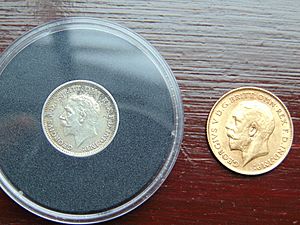
In October 2019, it was announced that 120,000 silver threepence coins, all from 1935 or earlier, would be sold to the public. This was done to encourage more people to start collecting coins. The London Mint Office managed the sale of these coins, which were all from King George V's rule.
See also
- Irish three-pence coin
- Australian threepence coin
- New Zealand pound


